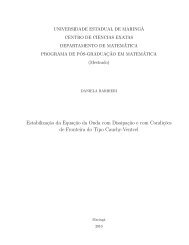UNIVERSIDADE ESTADUAL DE MARING´A CENTRO DE ... - PMA
UNIVERSIDADE ESTADUAL DE MARING´A CENTRO DE ... - PMA
UNIVERSIDADE ESTADUAL DE MARING´A CENTRO DE ... - PMA
Create successful ePaper yourself
Turn your PDF publications into a flip-book with our unique Google optimized e-Paper software.
1.6 Índice de Interseção 39<br />
onde (t n , ϕ(t)) é qualquer parametrização primitiva de f e pondo vf(0) = ∞.<br />
Teorema 1.62. Sejam f e g pseudo polinômios em K[[X]][Y ]. Seja f = f1 · ... · fr uma<br />
decomposição de f em fatores irredutíveis. Então,<br />
I(f, g) =<br />
r�<br />
i=1<br />
vfi (g).<br />
Demonstração: Ver demonstração em [H]. �<br />
Observe que pelo teorema acima, se f for irredutível então I(f, g) = vf(g) para todo<br />
g ∈ K[[X, Y ]].<br />
Teorema 1.63. Sejam f, g ∈ M. Então<br />
I(f, g) ≥ mult(f) · mult(g)<br />
com igualdade se, e somente se, (f) e (g) não possuem tangentes em comum.<br />
Demonstração: Sejam f = f1 · ... · fr e g = g1 · ... · gs a decomposição de f e g em<br />
fatores irredutíveis. Do Teorema (1.58) item (2) e (4) obtemos,<br />
I(f, g) = �<br />
I(fi, gj). (1.9)<br />
Por outro lado, como mult(h1h2) = mult(h1) + mult(h2) temos<br />
i,j<br />
mult(f)mult(g) = �<br />
mult(fi)mult(gj). (1.10)<br />
Logo, se I(fi, gj) ≥ mult(fi) · mult(gj), para todo i, j, temos de (1.9) e (1.10) que<br />
i,j<br />
I(f, g) = �<br />
I(fi, gj) ≥ �<br />
mult(fi)mult(gj) = mult(f) · mult(g).<br />
i,j<br />
i,j<br />
Portanto, podemos observar que é suficiente provarmos o teorema para f e g irredutíveis.<br />
Do item (3) do Teorema (1.58) o índice de interseção é invariante por mudança de<br />
coordenadas. Sendo assim, podemos assumir, após uma mudança de coordenadas ade-






